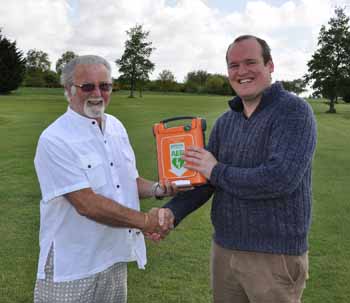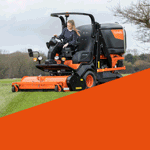Why defibrillators are saving lives at golf clubs
While there are very few studies in this country about the relationship between golf and heart attacks, many managers may not be surprised to know that the American Heart Association believes that, due to a range of reasons including the gender and age profile of the average club member, the time they are most likely to play golf and the effort exerted, ‘golf courses are among the most common places for heart attacks to occur’. What’s worse, due to the remote location of courses, experiencing a cardiac arrest on one is likely to be deadly – over 95 per cent of heart attacks on golf courses result in death, which is above the national average. Another US study two years ago found that over 3,000 golfers die on American courses every year due to cardiac arrests, with the third and 18th holes proving to be the deadliest locations. An internet search for ‘golf club’ and ‘heart attack’ in the UK shows the problem is not confined to one country. Ruthin-Pwllglas GC in Wales, for example, has seen two members die on the course in recent years; the club captain of Sundridge Park GC in Kent suffered a fatal attack on his course this summer; the KP Club in York and Nazeing GC in Essex have both also experienced deaths recently. So what can be done?
Defibrillators
If your club has an Automated External Defibrillator (AED), which delivers electric shocks across the chest to bring the heart into a ‘normal’ rhythm, and staff, members and / or greenkeepers are trained to use it, then, according to the British Heart Foundation (BHF), the chances of the golfer surviving an attack increases ‘greatly’ from less than five per cent without one. This is because the chance of successful defibrillation declines at a rate of over 20 per cent per minute unless chest compressions are given (which is also a good reason for your staff and members to be trained in CPR) and the average response time of an ambulance to a resuscitation situation is over five minutes longer if the person is in the middle of a golf course.
Ruthin-Pwllglas responded to its two deaths by becoming only the second club in Wales to purchase its own AED, and a team of members have been trained by the Welsh Ambulance Service to use the electric shock machine. Club captain Geoff Gill said: “We lost two long-standing club members in the recent past who have had heart attacks on the course. Pwllglas is a hilly course and we aren’t getting any younger so it’s a matter of making it a safer place for people to play, so I decided that the Captain’s Charity Fund from my year in office should be spent on a defibrillator. The Welsh Ambulance Service do a brilliant job but this is quite a remote location. If we can get help to someone in difficulty as quickly as possible it will give them a greater chance of survival.”
Welsh Ambulance Service paramedic Gerard Rothwell added: “The earlier someone suffering from a fatal heart attack receives chest compressions and defibrillation, the greater the chance of survival.”

Proof that these procedures work and that deaths can be prevented comes from the 2009 Manager of the Year finalist, Keith Adderley, secretary of Temple Golf Club in Berkshire, who recommended the purchase of a portable defibrillator and, just a few days after purchase, his assistant Matthew Wellings, suffered a cardiac arrest at the club. Keith used the defibrillator to save his life. “Unbeknown to me, my heart went into ventricular fibrillation,” said Matthew. “Without any hesitation, Keith used the equipment to shock my heart back into rhythm. Fortunately, I’m here to tell this story!” Similarly, Terry Blake, a keen swimmer, suffered a heart attack in a public pool a few years ago, and a member of staff used an AED to save his life. “I wouldn’t be here if it wasn’t for the defibrillator,” said Terry. “Everywhere open to the public should have one.”
Cost
Costs for AEDs, which are designed to be used by members of the public, vary and it may be possible to secure a grant for one. Wrekin Golf Club in Shropshire installed an AED in its clubhouse three years ago, spending nearly £2,000 on the machine, training and other first aid training (most AED suppliers will provide training). The sum was paid for 50/50 by a BHF grant and a donation from the club’s veterans’ section.
Liability
The Resuscitation Council (UK), the UK body responsible for setting central standards for cardiopulmonary resuscitation, in the following statement, advises golf clubs to seek training prior to using AEDs but adds that those who use them to save lives, in the event that no trained operator is at the emergency site, will not be held liable if they do not, even if they have had no training at all:
The majority of people who survive a cardiac arrest are resuscitated from ventricular fibrillation (VF) by the administration of a defibrillatory shock. This is most likely to be successful when it is given very soon after the onset of VF; emergency service personnel are often unable to arrive soon enough to help a victim.
AEDs are designed to be used by members of the public, and are very effective at guiding the operator through the process of administering the shock. They have become widely available, are safe and easy to use, and will not allow a shock to be given to a victim who does not require one.
AEDs have been used frequently by laypeople with modest training, and many reports testify to the success of this strategy. Operators without formal training have also used AEDs successfully to save lives.
While it is highly desirable that those who may be called upon to use an AED should be trained in their use, and keep their skills up to date, circumstances can dictate that no trained operator (or a trained operator whose certificate of training has expired) is present at the site of an emergency.
Under these circumstances no inhibitions should be placed on any person willing to use an AED.
The use of AEDs should not be restricted to trained personnel. We consider it inappropriate to display notices to the effect that only trained personnel should use the devices, or to restrict their use in other ways.
Such restrictions are against the interests of victims of cardiac arrest, and discourage the greater use of AEDs by members of the public who may be able to preserve life and assist victims of cardiac arrest.
3 Comments
Write a comment
Join Our Mailing List
Read the latest issues
Advertise With Us
| Alistair.Dunsmuir@hdidmedia.com |
For advertising enquiries in the magazine or online, contact:
| georgina.hirst@hdidmedia.com |
Recent Comments
- Mark Allan on “It’s been mentally brilliant for me”
- Dove on New 18-hole course to open next year
- GBMC on Meet the head professional: Alasdair Good
- Taylormade Ambassador on Meet the head professional: Alasdair Good
- Joe Brazil on Meet the head professional: Alasdair Good
















Generally golf course is the fifth most likely place to have a sudden cardiac arrest, so many golf clubs are now keeping automatic external defibrillators (AEDs) to make the golf course “heart safe”.
Thanks
http://www.teeoffenergy.com/product/
Nice blog right here! Additionally your web site lots up very fast!
What web host are you the use of? Can I am getting your associate hyperlink to your host?
I desire my site loaded up as fast as yours lol
Every year in the UK, scores of thousands of people suffer a cardiac arrhythmia or sudden cardiac arrest (SCA), often after a heart attack, in which the heart suddenly stops beating. If this happens, blood stops flowing to the brain and other organs, meaning the person who has suffered the SCA has just minutes to live if left untreated.
Most people who experience an SCA die, because the chances of survival decrease by as much as ten per cent per minute without treatment. And those most at risk are men aged over 45.
In other words, the average golf club member is more likely to suffer a cardiac arrhythmia than most, and if he or she has an SCA on the golf course then there is very little chance of survival due to how long it will take for an ambulance to arrive. Sundridge Park GC, Great Barr GC and Saddleworth GC, to name just three, have all experienced a golfer’s death on the course as a result of an SCA this year.
Some deaths on golf courses can be prevented though. If an automated external defibrillator (AED) is used within four minutes of the cardiac arrest then survival chances increase by 50 per cent. AEDs, which deliver electrical therapy to the patient’s body, have been modified in recent years so that they are relatively easy for lay people to use. The companies that manufacture them generally offer training, and the British Heart Foundation believes that no constraints should be placed on a person willing to use one.
All golf clubs should consider purchasing one (it may be that all that is necessary is just a £1 donation from each member to fund an AED, while grants might also be available).
Easy-to-access defibrillators are proven to save lives.